Bibliometric Review: Classroom Management in ADHD—Is There a Communication Gap Concerning Knowledge Between the Scientific Fields Psychiatry/Psychology and Education?
Abstract
1. Introduction
- The scientific fields of psychology/psychiatry and education hold different intellectual knowledge regarding the usage of CMS for ADHD.
- There is a communication gap between the scientific fields of psychology/psychiatry and education in the current literature concerning the exchange of knowledge.
- Literature across both fields fails to focus on how to implement CMS in schools, how to support the teachers, or how to overcome possible barriers when implementing the CMS.
2. Materials and Methods
2.1. Literature Search
2.2. Bibliometric Methods
2.2.1. Co-citation Analysis
2.2.2. Bibliographic Coupling
2.3. Data Cleaning and Analyzing
2.4. Interpretation of the Clusters
3. Results
3.1. Descriptive Results
3.2. Co-citation Analyses
3.3. Bibliographic Coupling Analysis
4. Discussion
4.1. Study Results
4.1.1. Co-citation Analyses: Basis of Current Stock of Knowledge of both Fields
4.1.2. Current Research Approaches
4.1.3. Investigation of Implementation Strategies and Barriers
4.2. Implications
4.3. Limitations
5. Conclusions
Supplementary Materials
Author Contributions
Funding
Conflicts of Interest
References
- Willcutt, E.G. The Prevalence of DSM-IV Attention-Deficit/Hyperactivity Disorder: A Meta-Analytic Review. Neurotherapeutics 2012, 9, 490–499. [Google Scholar] [CrossRef]
- Polanczyk, G.; de Lima, M.S.; Horta, B.L.; Biederman, J.; Rohde, L.A. The worldwide prevalence of ADHD: A systematic review and metaregression analysis. Am. J. Psychiatry 2007, 164, 942–948. [Google Scholar] [CrossRef]
- Polanczyk, G.; Willcutt, E.; Salum, G.; Kieling, C.; Rohde, L.A. ADHD prevalence estimates across three decades: An updated systematic review and meta-regression analysis. Int. J. Epidemiol. 2014, 43, 434–442. [Google Scholar] [CrossRef]
- Swanson, J.; Sergeant, J.; Taylor, E.; Sonuga-Barke, E.; Jensen, P.; Cantwell, D.; Jensen, P.S. Attention-deficit hyperactivity disorder and hyperkinetic disorder. Lancet 1998, 351, 429–433. [Google Scholar] [CrossRef]
- Frazier, T.W.; Youngstrom, E.A.; Glutting, J.J.; Watkins, M.W. ADHD and achievement: Meta-analysis of the child, adolescent, and adult literatures and a concomitant study with college students. J. Learn. Disabil. 2007, 40, 49–65. [Google Scholar] [CrossRef]
- Rohde, L.A.; Biederman, J.; Busnello, E.A.; Zimmermann, H.; Schmitz, M.; Martins, S.; Tramontina, S. ADHD in a School Sample of Brazilian Adolescents: A Study of Prevalence, Comorbid Conditions, and Impairments. J. Am. Acad. Child Adolesc. Psychiatry 1999, 38, 716–722. [Google Scholar] [CrossRef] [PubMed]
- DuPaul, G.J.; Langberg, J.M. Educational impairments in children with ADHD. In Attention-Deficit Hyperactivity Disorder: A Handbook for Diagnosis and Treatment: Educational Impairments in Children with ADHD, 3rd ed.; Barkley, R.A., Ed.; The Guilford Press: New York, NY, USA, 2015; pp. 169–190. [Google Scholar]
- Conners, C.K.; Epstein, J.N.; March, J.S.; Angold, A.; Wells, K.C.; Klaric, J.; Greenhill, L.L. Multimodal Treatment of ADHD in the MTA: An Alternative Outcome Analysis. J. Am. Acad. Child Adolesc. Psychiatry 2001, 40, 159–167. [Google Scholar] [CrossRef] [PubMed]
- van der Oord, S.; Prins, P.J.; Oosterlaan, J.; Emmelkamp, P.M. Efficacy of methylphenidate, psychosocial treatments and their combination in school-aged children with ADHD: A meta-analysis. Clin. Psychol. Rev. 2008, 28, 783–800. [Google Scholar] [CrossRef] [PubMed]
- DuPaul, G.J.; Weyandt, L.L.; Janusis, G.M. ADHD in the Classroom: Effective Intervention Strategies. Theory Pract. 2011, 50, 35–42. [Google Scholar] [CrossRef]
- DuPaul, G.J.; Weyandt, L.L. School-based Intervention for Children with Attention Deficit Hyperactivity Disorder: Effects on academic, social, and behavioural functioning. Int. J. Disabil. Dev. Educ. 2006, 53, 161–176. [Google Scholar] [CrossRef]
- Gaastra, G.F.; Groen, Y.; Tucha, L.; Tucha, O. The Effects of Classroom Interventions on Off-Task and Disruptive Classroom Behavior in Children with Symptoms of Attention-Deficit/Hyperactivity Disorder: A Meta-Analytic Review. PLoS ONE 2016, 11, e0148841. [Google Scholar] [CrossRef] [PubMed]
- Reid, R.; Trout, A.L.; Schartz, M. Self-regulation interventions for children with attention deficit/hyperactivity disorder. Except. Child. 2005, 71, 361–377. [Google Scholar]
- Ruhmland, M.; Christiansen, H. Konzepte zu Grundlagen von ADHS und Interventionen im Unterricht bei Grundschullehrkräften. Psychol. Erzieh. Unterr. 2017, 64, 109–122. [Google Scholar] [CrossRef]
- Dort, M.; Strelow, A.; Schwinger, M.; Christiansen, H. What teachers think and know about ADHD: Validation of the ADHD-school-expectation questionnaire (ASE). Int. J. Disabil. Dev. Educ. 2020, in press. [Google Scholar]
- Strelow, A.E.; Dort, M.; Schwinger, M.; Christiansen, H. Influences on pre-service teachers’ intention to use classroom management strategies for students with ADHD: A model analysis. Int. J. Educ. Res. 2020, 103, 101627. [Google Scholar] [CrossRef]
- DuPaul, G.J.; Chronis-Tuscano, A.; Danielson, M.L.; Visser, S.N. Predictors of Receipt of School Services in a National Sample of Youth With ADHD. J. Atten. Disord. 2019, 23, 1303–1319. [Google Scholar] [CrossRef]
- Gaastra, G.F.; Groen, Y.; Tucha, L.; Tucha, O. Unknown, Unloved?: Teachers’ Reported Use and Effectiveness of Classroom Management Strategies for Students with Symptoms of ADHD. Child Youth Care Forum 2019, 22, 115. [Google Scholar] [CrossRef]
- Diodato, V.P.; Gellatly, P. Dictionary of Bibliometrics; Routledge: London, UK, 2013. [Google Scholar]
- Zupic, I.; Čater, T. Bibliometric Methods in Management and Organization. Organ. Res. Methods 2015, 18, 429–472. [Google Scholar] [CrossRef]
- Boyack, K.W.; Klavans, R. Creation of a highly detailed, dynamic, global model and map of science. J. Assn. Inf. Sci. Tec. 2014, 65, 670–685. [Google Scholar] [CrossRef]
- McCain, K.W. Mapping authors in intellectual space: A technical overview. J. Am. Soc. Inf. Sci. 1990, 41, 433–443. [Google Scholar] [CrossRef]
- Andersen, N. Mapping the expatriate literature: A bibliometric review of the field from 1998 to 2017 and identification of current research fronts. Int. J. Hum. Resour. Manag. 2019, 1, 1–38. [Google Scholar] [CrossRef]
- Pasadeos, Y.; Phelps, J.; Kim, B.-H. Disciplinary Impact of Advertising Scholars: Temporal Comparisons of Influential Authors, Works and Research Networks. J. Advert. 1998, 27, 53–70. [Google Scholar] [CrossRef]
- Kessler, M.M. Bibliographic coupling between scientific papers. Am. Doc. 1963, 14, 10–25. [Google Scholar] [CrossRef]
- Lee, C.I.; Felps, W.; Baruch, Y. Toward a taxonomy of career studies through bibliometric visualization. J. Vocat. Behav. 2014, 85, 339–351. [Google Scholar] [CrossRef]
- Waltman, L.; van Eck, N.J.; Noyons, E.C.M. A unified approach to mapping and clustering of bibliometric networks. J. Inf. 2010, 4, 629–635. [Google Scholar] [CrossRef]
- Bonacich, P. Factoring and weighting approaches to status scores and clique identification. J. Math. Sociol. 1972, 2, 113–120. [Google Scholar] [CrossRef]
- Egan, T.E.; Wymbs, F.A.; Owens, J.S.; Evans, S.W.; Hustus, C.; Allan, D.M. Elementary school teachers’ preferences for school-based interventions for students with emotional and behavioral problems. Psychol. Sch. 2019, 56, 1633–1653. [Google Scholar] [CrossRef]
- French, B.; Sayal, K.; Daley, D. Barriers and facilitators to understanding of ADHD in primary care: A mixed-method systematic review. Eur. Child Adolesc. Psychiatry 2019, 28, 1037–1064. [Google Scholar] [CrossRef]
- Mixon, C.S.; Owens, J.S.; Hustus, C.; Serrano, V.J.; Holdaway, A.S. Evaluating the Impact of Online Professional Development on Teachers’ Use of a Targeted Behavioral Classroom Intervention. Sch. Ment. Health 2019, 11, 115–128. [Google Scholar] [CrossRef]
- Hursh, D. No child left behind: The rise of educational markets and the decline of social justice. In Social Justice in These Times: (International Social Studies Forum: The Series); James, O., Marc, P., Rudolfo, C.C., Eds.; Information Age Publishing: Charlotte, NC, USA, 2004; pp. 173–190. ISBN 1593112181. [Google Scholar]
- Montoya, A.; Colom, F.; Ferrin, M. Is psychoeducation for parents and teachers of children and adolescents with ADHD efficacious? A systematic literature review. Eur. Psychiatry 2011, 26, 166–175. [Google Scholar] [CrossRef]
- Banaschewski, T.; Hohmann, S.; Millenet, D.P.S. Leitlinienreport der Interdisziplinären Evidenz- und Konsensbasierten (S3) Leitlinie „Aufmerksamkeitsdefizit-/Hyperaktivitätsstörung (ADHS) im Kindes-, Jugend- und Erwachsenenalter“. Available online: https://www.awmf.org/uploads/tx_szleitlinien/028-045m_S3_ADHS_2018-06.pdf (accessed on 22 August 2020).
- National Institute of Mental Health. Attention-Deficit/Hyperactivity Disorder. Available online: https://www.nimh.nih.gov/health/topics/attention-deficit-hyperactivity-disorder-adhd/index.shtml (accessed on 20 March 2020).
- Cohen, J. Statistical Power Analysis for the Behavioral Sciences, 2nd ed.; L. Erlbaum Associates: Hillsdale, NJ, USA, 1988. [Google Scholar]
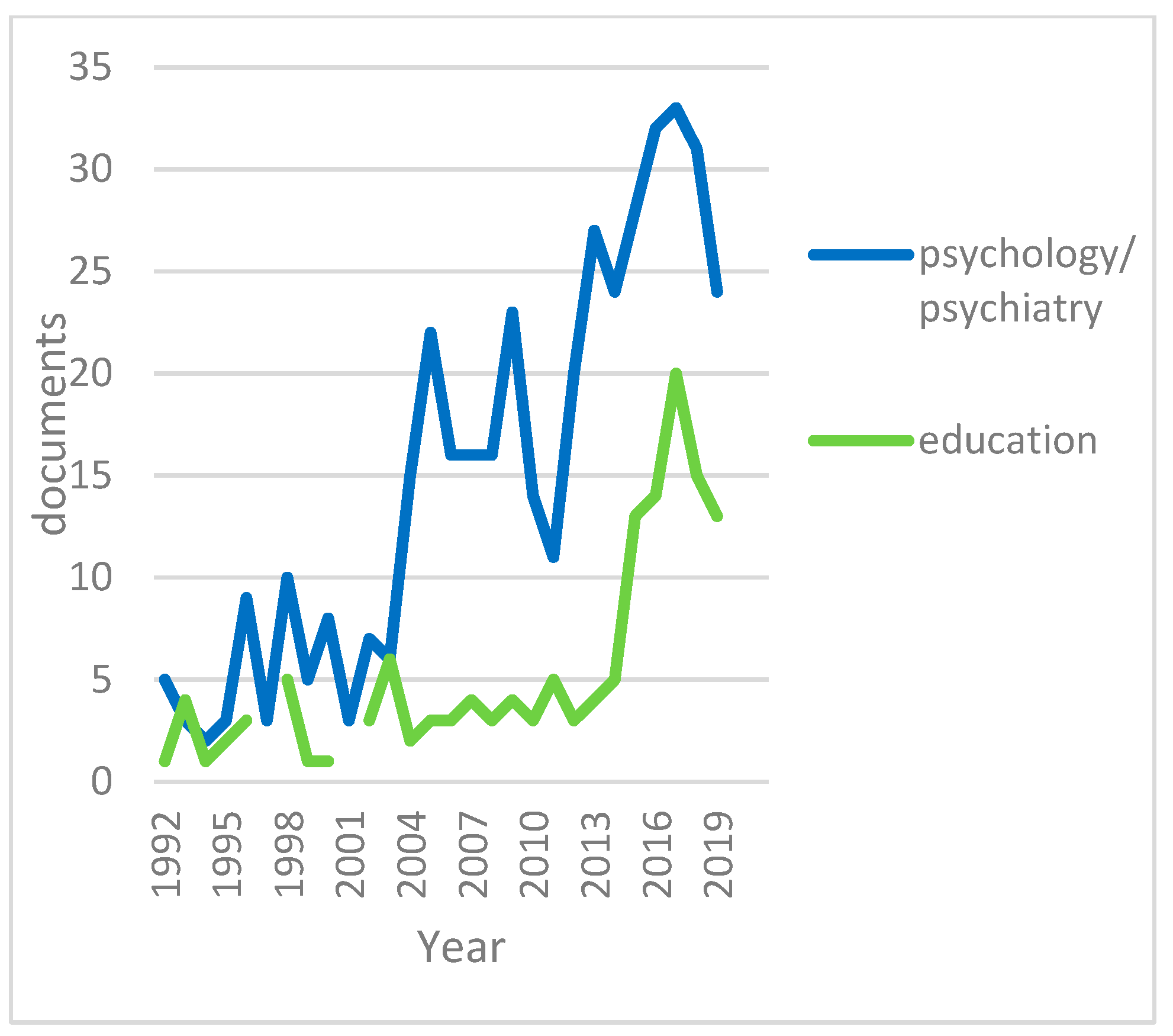
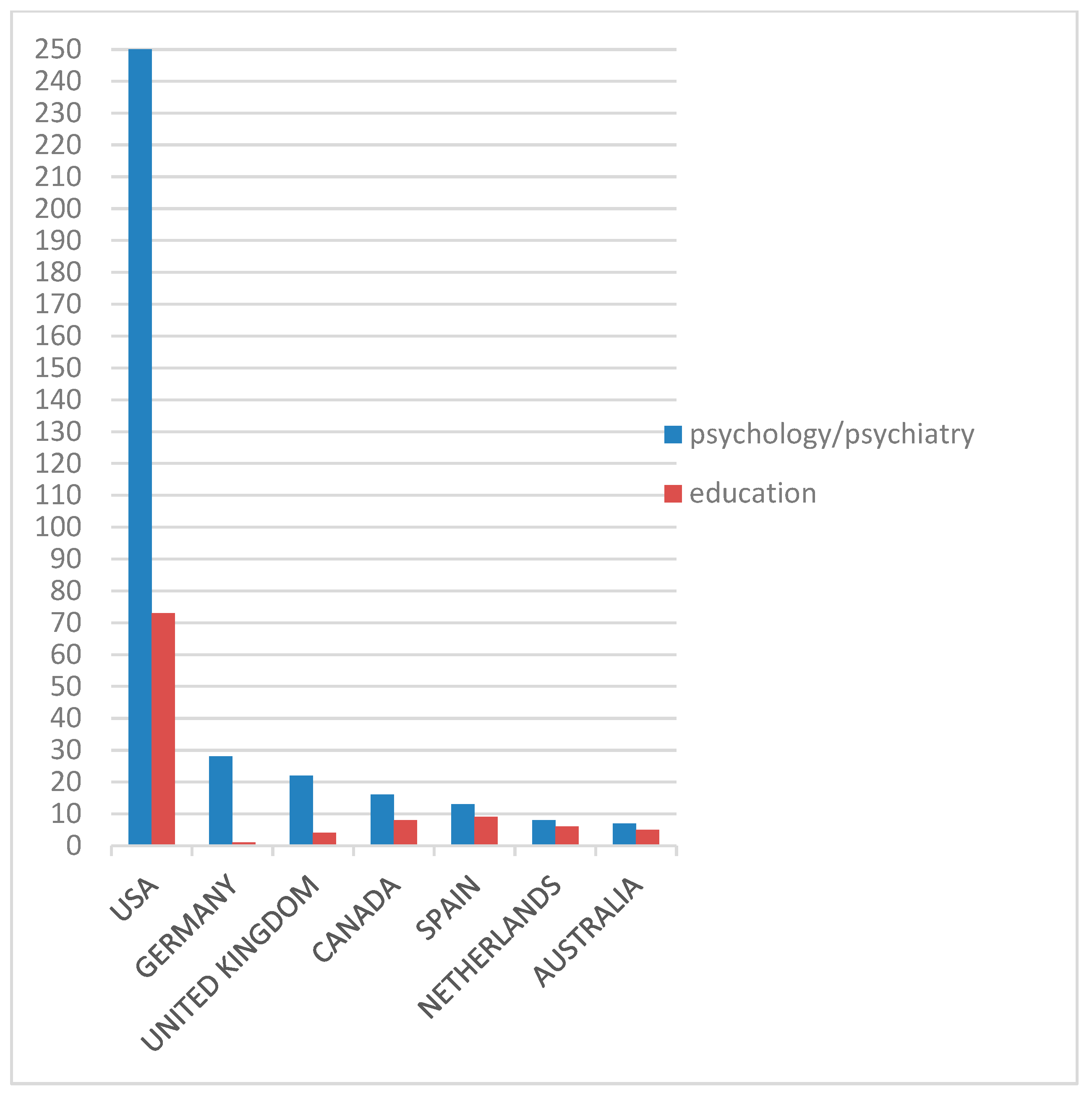
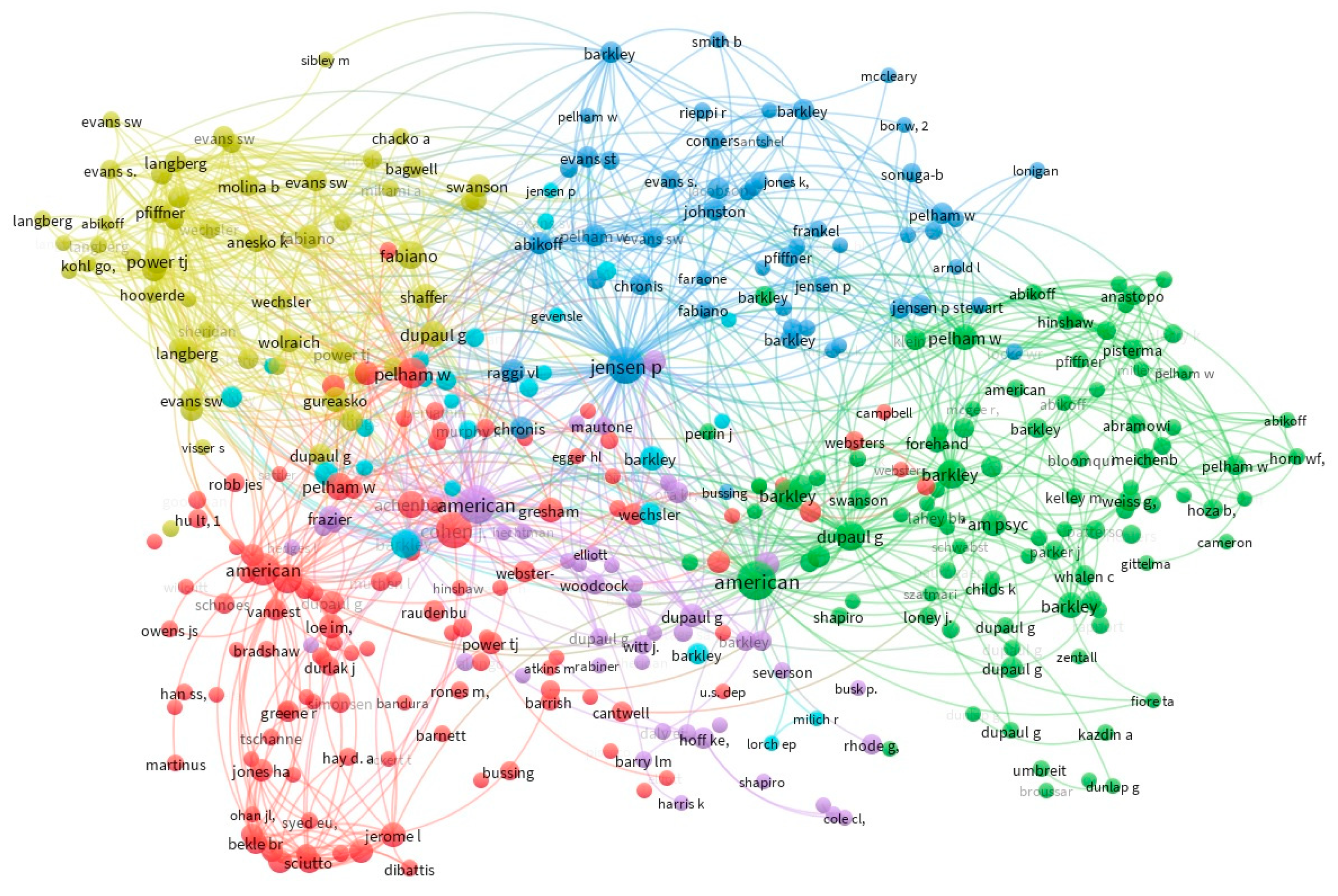
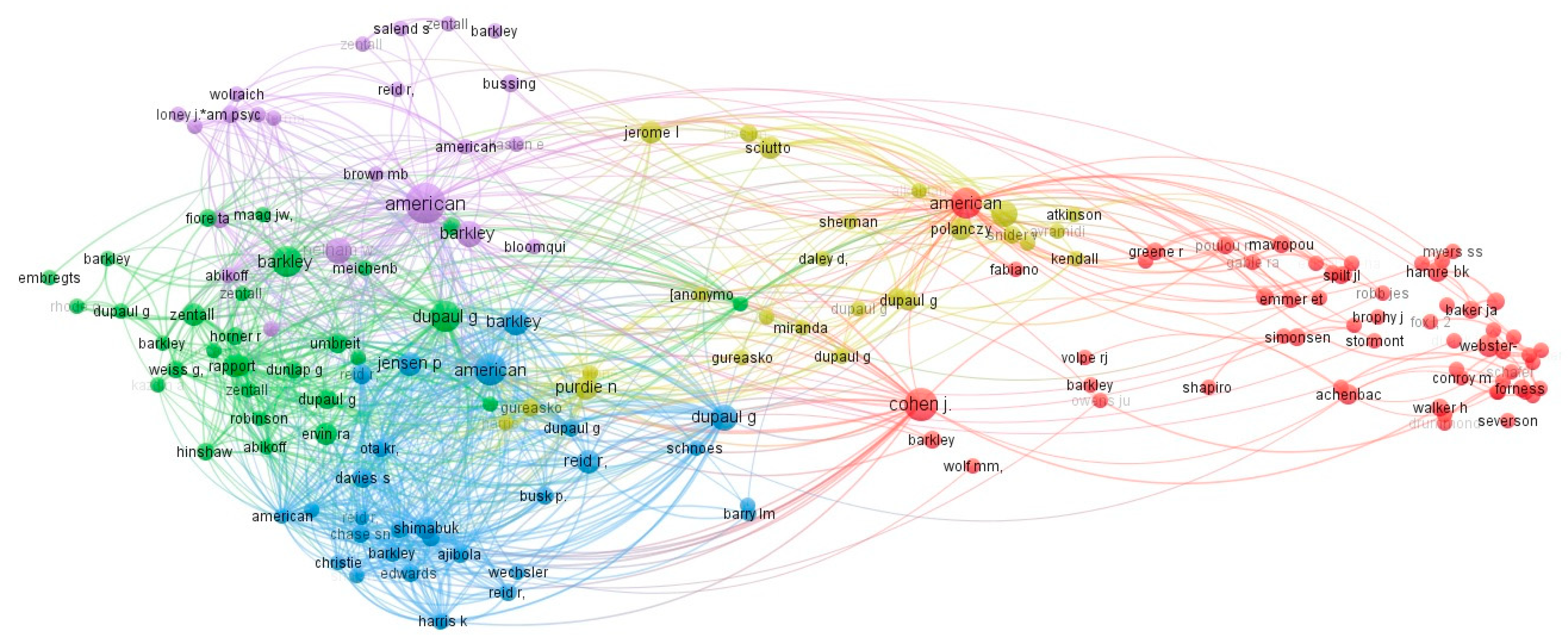
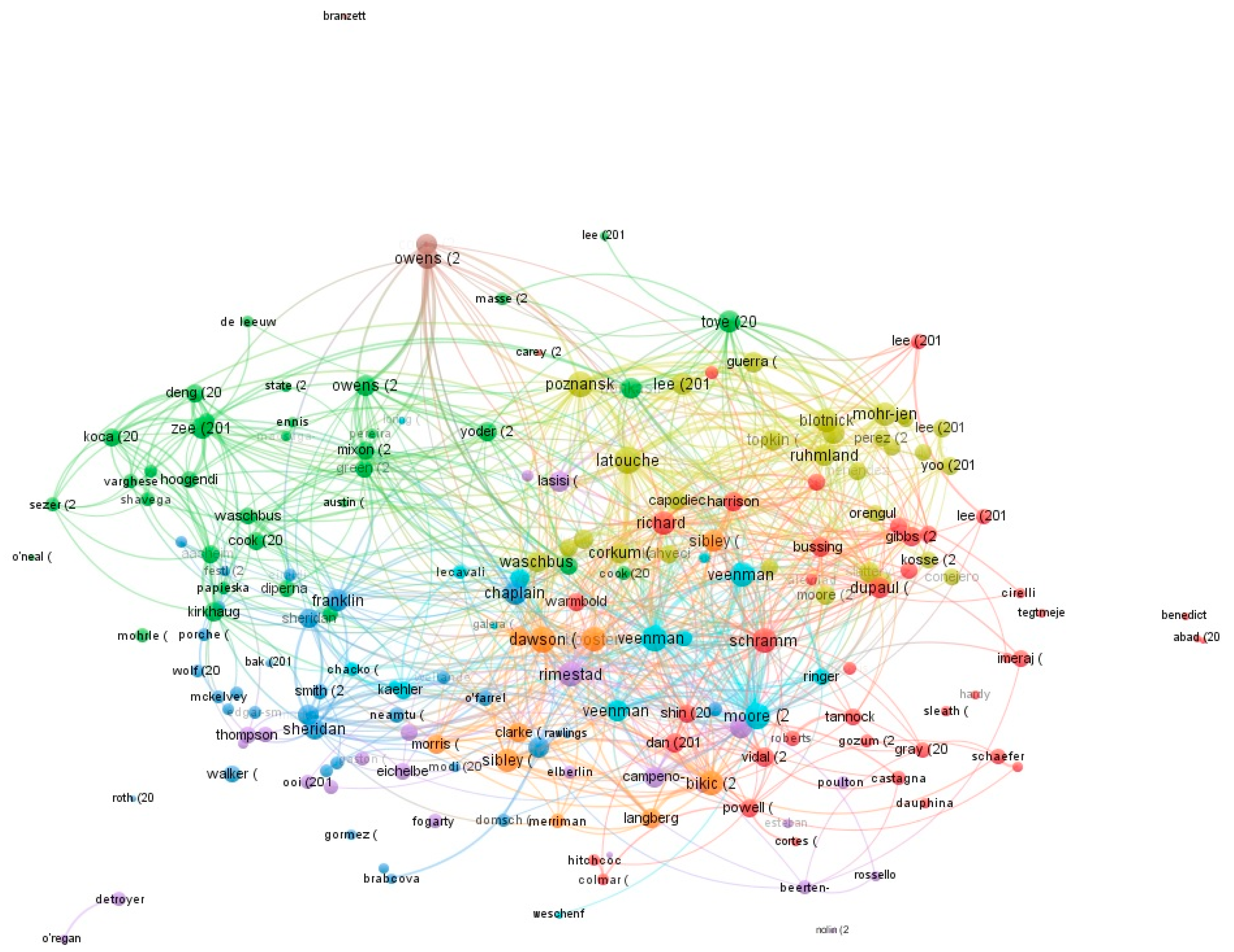
| Terms for ADHD | AND | Terms for CMS | AND | Terms for Scientific fields | AND | Term for Time Span * | |||||
| TS = (“ADHD”) (“AD/HD”) (“attention deficit”) (“hyperactive" *) (“hyperkine" *) (“externali" *) | OR OR OR OR OR | TS = (“antecedent-based”) (“antecedent based”) (“consequen *-based”) (“consequen *-based”) (“self-management”) (“self-management”) | OR OR OR OR OR OR | SU = (Psychology) (Psychiatry) respectively | OR | PY = (2015–2019) | |||||
| (“school (“classroom (“education * (“academic * (“teacher * | + | Intervent *”) Manage *”) train*”) strateg*”) treat*”) program”) therapy”) | OR OR OR OR OR OR | SU = (Education & Educational Research) | |||||||
| No. of Cited Documents | Main Topic(s) | Color |
|---|---|---|
| 111 | meaning of ADHD in the school; psychosocial treatment | |
| 98 | medical, behavioral, and cognitive treatment; ADHD accompaniments | |
| 54 | comparison and combination of treatments; influential family-based factors | |
| 54 | academic functioning; research methods | |
| 46 | academic performance; handling of disruptive behavior | |
| 26 | conception of ADHD over lifetime |
| No. of Cited Documents | Main Topic(s) | Color |
|---|---|---|
| 60 | teachers’ perception and handling of challenging behavior | |
| 30 | evidence-based classroom interventions; single approaches | |
| 29 | self-management and guidance for pupils with ADHD | |
| 25 | teachers’ knowledge and perception of ADHD; intervention effects | |
| 22 | diagnosis and treatment of ADHD according DSM IV and older |
| No. of Documents Total | No. of Documents Psych. | No. of Documents Education | Main Topic(s) | Color |
|---|---|---|---|---|
| 41 | 23 | 18 | treatment effects and perception of ADHD | |
| 34 | 14 | 20 | challenging behavioral problems | |
| 32 | 24 | 8 | programs; importance of ADHD in schools, families, and society | |
| 30 | 23 | 7 | self-efficacy; knowledge about ADHD | |
| 24 | 19 | 5 | treatment effect studies | |
| 15 | 12 | 3 | moderators of treatment effects | |
| 10 | 10 | − | the role of parents/families | |
| 3 | 2 | 1 | implementation strategies |
© 2020 by the authors. Licensee MDPI, Basel, Switzerland. This article is an open access article distributed under the terms and conditions of the Creative Commons Attribution (CC BY) license (http://creativecommons.org/licenses/by/4.0/).
Share and Cite
Dort, M.; Strelow, A.E.; French, B.; Groom, M.; Luman, M.; Thorell, L.B.; Biele, G.; Christiansen, H. Bibliometric Review: Classroom Management in ADHD—Is There a Communication Gap Concerning Knowledge Between the Scientific Fields Psychiatry/Psychology and Education? Sustainability 2020, 12, 6826. https://doi.org/10.3390/su12176826
Dort M, Strelow AE, French B, Groom M, Luman M, Thorell LB, Biele G, Christiansen H. Bibliometric Review: Classroom Management in ADHD—Is There a Communication Gap Concerning Knowledge Between the Scientific Fields Psychiatry/Psychology and Education? Sustainability. 2020; 12(17):6826. https://doi.org/10.3390/su12176826
Chicago/Turabian StyleDort, Martina, Anna Enrica Strelow, Blandine French, Madeleine Groom, Marjolein Luman, Lisa B. Thorell, Guido Biele, and Hanna Christiansen. 2020. "Bibliometric Review: Classroom Management in ADHD—Is There a Communication Gap Concerning Knowledge Between the Scientific Fields Psychiatry/Psychology and Education?" Sustainability 12, no. 17: 6826. https://doi.org/10.3390/su12176826
APA StyleDort, M., Strelow, A. E., French, B., Groom, M., Luman, M., Thorell, L. B., Biele, G., & Christiansen, H. (2020). Bibliometric Review: Classroom Management in ADHD—Is There a Communication Gap Concerning Knowledge Between the Scientific Fields Psychiatry/Psychology and Education? Sustainability, 12(17), 6826. https://doi.org/10.3390/su12176826







